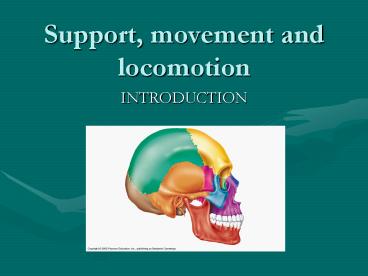Support, movement and locomotion - PowerPoint PPT Presentation
1 / 28
Title: Support, movement and locomotion
1
Support, movement and locomotion
- INTRODUCTION
2
Objectives
- List and describe the major functions of the
skeletal system. - List, describe and give specific examples of the
types of bones. - List and describe the two major divisions of the
skeletal system and the bones which compose each. - Describe the process of bone formation.
- List and describe the various types of joints.
3
Functions of the Skeletal System
- Support of the body
- Protection of soft organs
- Movement due to attached skeletal muscles
- Storage of minerals and fats
- Blood cell formation
4
Classification of Bones by Shape
- Long bones
- Typically longer than wide
- Have a shaft (long, central cylinder) with heads
at both ends - Contain mostly compact bone
- Examples Femur, humerus
- Short bones
- Generally cube-shape
- Contain mostly spongy bone
- Examples Carpals, tarsals
- Flat bones
- Thin and flattened
- Usually curved
- Thin layers of compact bone around a layer of
spongy bone - Examples Skull, ribs, sternum
- Irregular bones
- Irregular shape
- Usually with projections (processes) or openings
(foramen) - Do not fit into other bone classification
categories - Example Vertebrae and hip
5
Classification of Bones by Shape
6
Divisions of the Skeleton
- The Skeleton is divided into two major regions
- a. Axial Skeleton
- b. Appendicular Skeleton
- The Axial Skeleton forms the longitudinal part of
the body - Divided into three parts
- Skull
- Vertebral column
- Bony thorax
- The Appendicular skeleton is composed of the
appendages and the joints which attach them to
the axial skeleton - Limbs (appendages)
- Pectoral girdle (shoulder, scapula, and
clavicle) - Pelvic girdle (pelvis)
7
Divisions of the Skeleton
8
Axial Skeleton The Skull
- Two sets of bones
- Cranium
- Facial bones
- Bones are joined by sutures (fixed, non-movable
joints) - Only the mandible is attached by a freely movable
joint
9
Axial Skeleton The Skull
10
Axial Skeleton The Skull
11
Axial Skeleton Hyoid Bone
- The only bone that does not articulate with
another bone - Serves as a moveable base for the tongue
Figure 5.12
12
Axial Skeleton Vertebral Column
- Vertebrae are separated by intervertebral discs
composed of fibrocartilage - The spine has a normal curvature
- Each vertebrae is given a name according to its
location
13
Axial Skeleton Vertebral Column
14
Axial Skeleton Anterior Thorax
- Forms a cage to protect major organs
- Made-up of two parts
- 1. Sternum
- 2. Ribs
15
Appendicular Skeleton Pectoral Girdle
- Composed of two bones
- Clavicle collarbone
- Scapula shoulder blade
- These bones allow the upper limb to have
exceptionally free movement
16
Appendicular Skeleton Pectoral Girdle (Shoulder)
17
Appendicular Skeleton Brachium Region
- The arm is formed by a single bone
- Humerus
18
Appendicular Skeleton Antebrachium Region
- The forearm has two bones
- Ulna (side adjacent to little finger)
- Radius (side adjacent to thumb)
19
Appendicular Skeleton Carpus, Manus, and Digits
Region
- The hand
- Carpals wrist
- Metacarpals palm
- Phalanges fingers
20
Articulations Joints
- A joint is a location where two or more bones
meet. - Functions of joints
- Hold bones together
- Allow for mobility
- Ways joints are classified
- Functionally
- Structurally
21
Types of Joints
- Fibrous joints
- Generally immovable (sutures of skull)
- Cartilaginous joints
- Immovable or slightly moveable (vertebral disc)
- Synovial joints
- Freely moveable (shoulder, pelvis, knee, elbow,
digits) - Articulating bones are separated by a joint
cavity - Synovial fluid is found in the joint cavity
22
Structure of a Synovial Joint
Figure 5.28
23
Type of Synovial Joints
24
Types of Synovial Joints
25
Diseases and Disorders of the Skeletal System
- A fracture is a break in a bone
- Types of bone fractures
- Closed (simple) fracture break that does not
penetrate the skin - Open (compound) fracture broken bone penetrates
through the skin - Bone fractures are treated by reduction and
immobilization - Realignment of the bone
26
Diseases and Disorders of the Skeletal System
Fractures
Simple Complete fibula
Simple Greenstick radius
Compound Fracture tibia and fibula
Comminuted Fracture radius
27
Diseases and Disorders of the Skeletal System
- Osteoporosis This illness afflict both men and
women but it is most common in post menopausal
women. The bone tissue becomes brittle and
breaks easily with little applied stress. Due to
loss of calcium from the bone matrix.
28
Diseases and Disorders of the Skeletal System
- Rickets Rickets is a disease associated with a
deficiency of vitamin D in the diet. It prevents
the body from absorbing calcium needed for the
formation of strong, bone matrix. Typically the
long bones are soft and bend under the stress
from the weight of the body. It results in
bowed legs. This disease often affects
children who are undernourished.

